|
Model car built by Williams Howes in 1903 and restored by Dave Moller in 1998 The Youth Companion Ads by Juan Wilson © 1999 The Gobbler: Summer Growth My grandfather was William Howes of Panama, New York. Back when I was a kid, when I visited my grandparents, I was fascinated with something my grandfather had built. It was a small wooden car model. It was hand made and built from scratch, not from a kit. The original tires were made of carefully rolled and painted window putty. The steering arm was a bent and modified ladies hat pin. The wheel spokes were wire soldered to the rims. The metal steps were cut, stamped and bent using hand tools. It was a labor of love. Inexplicably, my grandfather let me play with it as if it were one of my toy cars. Over the years it got pretty banged up. After my grandfather died in 1965, the car became mine. Later the house he lived in became mine as well. Like the house, the car was a mess. Pieces were missing. The wheels were bent and it had been neglected and collected a lot of dust. For thirty years it sat on a shelf and occasionally I would tell a visitor that it was something my grandfather had made. Then a few years ago I was crawling through the attic in the oldest part of the house and I came across a stack of old magazines. They were issues of "The Youth Companion" from around the turn of the last century. The Youth Companion was geared to school age readers. There were puzzle pages for younger readers and adventure stories and tales of expeditions for the teenagers. This was the time when my grandfather had been a teenager. I figured these had been his. I looked through a couple. On one of the back pages of a July 16th, 1903 copy I saw something that jolted me. 
Ad for 1903 Model 21 Waverley electric car built by Pope Motor Car Co. It was an ad for something that had been familiar to me all my life but that I had never really seen; a Waverly Model 21 Electric Car built in Indianapolis, Indiana by the Pope Motor Car Company. The Waverley cost $850 without a top and as the ad said "No Complications. Turn on power and steer". It was undoubtedly the source of inspiration for the model my grandfather had built. Motivated by finding the source of the effort my grandfather had made I engaged my brother-in-law, Dave Moller to help restore the car. Dave's parents ran Craftworld on Cherry Street, in Jamestown, New York. Craftworld is a hobbyist's paradise and Dave grew up building model train layouts. For years he has been building an elaborate recreation of the Jamestown railyards as they were in the mid 1950's. Well, Dave restored the car beautifully. He cleaned up the metal and wood and replaced the putty tires with black rubber O-rings. Finally, he put the car in a plastic case to keep it dust free. My grandkids might get to see the old Waverley more than a century after it was built. 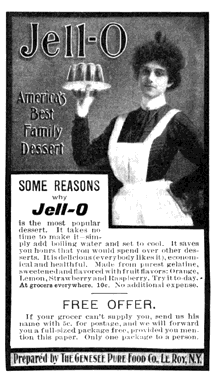
Ad for Jell-O dessert from the Genesee Pure Food Company, Le Roy, New York After my rewarding experience with the Waverley I left the stack of "Youth Companions" in a back room until just a few days ago. As we were putting this issue of the Gobbler together, I revisited the Youth Companion and started looking through the back pages and found ads for the Waverley in almost every issue. I began to wonder what else in the ad pages had inspired or intrigued William Howes back in 1903. Some of what I found wasn't so surprising. There were ads for Domino Sugar, Jell-O, Shredded Wheat and many brand names still familiar to most of us today. In 1903 Jell-O came in four flavors; orange , lemon, strawberry and raspberry. The Shredded Wheat people seemed to know that whole wheat had important nutritional benefits. In one ad they stated, "It is a remarkable fact that no other food takes the place of Shredded Wheat. This is true because in it the complete requirements of the body are found - the identical food counterparts of the human organism - its perfect food affinity." and "As a digestive and in cases of chronic constipation and dyspepsia it acts as one of the very best remedies I have ever prescribed: B. P. Anderson MD, Colorado Springs". 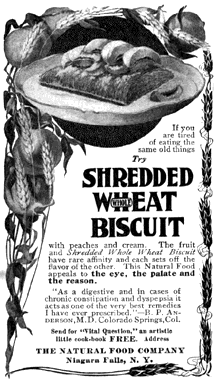
Ad for Shredded Wheat from the Natural Food Company, Niagara Falls, New York Other ads were not so familiar. In fact some were downright weird. Both boys and girls from the time they were toddlers were trussed up in corsets, garters and other odd paraphernalia. One ad, for the Ferris Brothers Company, used the image of a young girl in a corset and espoused... "Freedom in childhood. Growing children should be so clothed as to allow entire freedom of action, respiration and circulation. In their play they get in all kinds of positions - tight bands cause them discomfort and injury. Ferris Good Sense Waist supports the undergarments from the shoulders by means of the shoulder straps, training the growing body the way it should go. That's the reason the woman who has lived a lifetime in a Ferris Waist is healthy, vigorous, beautiful." 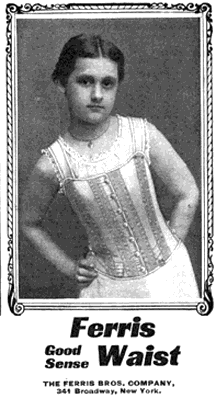
The Ferris Waist ad for style #215 from the Ferris Bros. Co., New York, New York The Youth Companion ads which had the biggest impact on me were the gun ads. In virtually all the issues I looked at there were ads for mail order guns. No age limits, no licenses: just cash and carry. Many of the gun manufacturers are the ones still active today... Marlin, Remington, Colt and even Daisy. 
Marlin Repeater ad from the Marlin Fire Arm Company, New Haven, Connecticut This Marlin Repeater ad states "Unequaled accuracy and penetration... the 196 page Sportsman Guide tells about powders, black and smokeless; styles of bullets, lead, alloyed, jacketed, soft-nosed, mushrooms etc.; trajectories, velocities and penetrations of all calibers from .22 to .45" 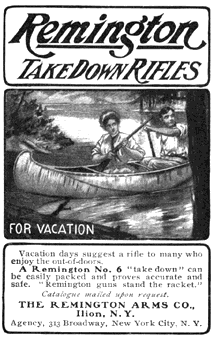
Remington Rifle ad from The Remington Arms Company, Ilion, New York The Take Down Rifle ad from Remington pictures a couple in a canoe. The young man paddling while the young woman, in a corset, holds a rifle at the ready. It states "Vacation days suggest a rifle to many who enjoy the out-of-doors. A Remington No. 6 'take down' can be easily packed and proves accurate and safe. Remington guns stand the racket" 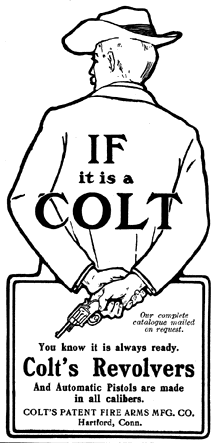
Colt Revolver ad from Colt's Patent Fire Arms Manufacturing Company, Hartford, Connecticut The Colt Revolver ad is succinct. It shows a man holding a pistol behind his back, finger on the trigger. It simply states "If it's a Colt, you know it's always ready." The Union Metallic Cartridge Company made ammunition. In their ad they picture a boy of six or seven holding a double barreled shotgun (as long as he is tall). Over his shoulder proudly hangs his kill. The ad states "A chip off the old block. Union Metallic Cartridges. They shoot well in any gun" 
UMC Bullet ad from Union Metallic Cartridge Company, Bridgeport Connecticut Perhaps the most disturbing ad I came across was from the Harrington & Richardson Arms Company. They marketed their product not as a real gun but as a toy. The ad pictures a prepubescent boy running through the streets with an American Flag in one hand a semiautomatic revolver in the other. The boy fires the gun in the air while explosions surround him. In the background several men and boys fire guns in the air. 
Ad for Young America Revolver from the Harrington & Richardson Arms Company, Wocester, Massachusetts The ad states "The Glorious 4th will soon be here, when every boy will want to make a noise. Don't run chances of lockjaw using a toy pistol, but buy a Young America Double Action Revolver $2.25. Safe. Reliable. 22 Caliber, 7-shot, rim fire, 32 Caliber, 5-shot rim or center fire." It this was the what the American public was doing back in the "Good Old Days", what are we worried about today? Certainly, this marketing worked. My grandfather bought several guns over his lifetime. When I was a young teenager he let me use a few of his many guns. My favorite was a pump action .22 caliber Remington Rifle. I used it for recreation... namely killing everything that moved and wasn't a domestic animal or person. That ended one summer evening in 1960 when I used my grandfather's Remington to kill skunk on it's way to grandmothers vegetable garden. It was right next to the house and the stink was terrible. My mother cried at the thought of my cruelty. I was ashamed and never owned a gun or used a gun to kill again. I wonder what would be in The Youth Companion back pages today?
|